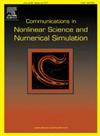基于VOF-to-DPM模型的人上呼吸道鼻内喷雾射流分解CFD建模
IF 3.8
2区 数学
Q1 MATHEMATICS, APPLIED
Communications in Nonlinear Science and Numerical Simulation
Pub Date : 2025-06-21
DOI:10.1016/j.cnsns.2025.109093
引用次数: 0
摘要
研究鼻内喷雾剂的动力学是改善药物输送以更有效地治疗鼻腔疾病的一个重要方面。本文采用VOF-to-DPM模型对鼻腔喷雾雾化过程进行了数值模拟。这个模型使我们能够描述空气中液体流动分解成微小液滴的过程。该研究还考虑了呼吸速度和频率对上呼吸道颗粒扩散的影响。为了研究颗粒的惯性运动,建立了一个模拟呼吸气流和液滴在鼻腔内转移的流体动力学的数值模型。这个模型可以将喷雾流描述为气流中连续流动的液体,然后变成离散的液滴。该模型还考虑了液滴与鼻腔壁面碰撞时的反弹、解体、粘附和扩散等各个方面的行为。结果表明,空气流速对壁膜质量分布、液滴大小和颗粒雾化特性影响不大。提出了一种利用VOF-to-DPM模型对液体喷雾在人鼻腔内雾化过程进行数值模拟的新方法。本文章由计算机程序翻译,如有差异,请以英文原文为准。
CFD modeling the disintegration of an intranasal spray jet in the human upper respiratory tract using the VOF-to-DPM model
Investigating the dynamics of intranasal spray represents an important aspect in the field of improving drug delivery for more effective treatment of nasal diseases. In this paper, a numerical simulation of the nasal spray nebulization process was carried out using the VOF-to-DPM model. This model allows us to describe the breakdown of a liquid flow in air into tiny droplets. The study also took into account the influence of breathing velocity and frequency on the spread of particles in the upper respiratory tract. To study the inertial motion of particles, a numerical model was developed for modeling the hydrodynamics of the respiratory air flow and the transfer of drops in the nasal cavity. This model makes it possible to describe a spray stream as a continuous flow of liquid in an air stream, which then turns into discrete droplets. The model also took into account various aspects of the behavior of droplets upon impact with the wall of the nasal cavity, including rebound, disintegration, adhesion and spreading. The results showed little effect of air flow rate on wall film mass distribution, droplet size, and particle spray atomization characteristics. A new approach using the VOF-to-DPM model is proposed to numerically simulate the process of liquid spray atomization in the human nasal cavity.
求助全文
通过发布文献求助,成功后即可免费获取论文全文。
去求助
来源期刊

Communications in Nonlinear Science and Numerical Simulation
MATHEMATICS, APPLIED-MATHEMATICS, INTERDISCIPLINARY APPLICATIONS
CiteScore
6.80
自引率
7.70%
发文量
378
审稿时长
78 days
期刊介绍:
The journal publishes original research findings on experimental observation, mathematical modeling, theoretical analysis and numerical simulation, for more accurate description, better prediction or novel application, of nonlinear phenomena in science and engineering. It offers a venue for researchers to make rapid exchange of ideas and techniques in nonlinear science and complexity.
The submission of manuscripts with cross-disciplinary approaches in nonlinear science and complexity is particularly encouraged.
Topics of interest:
Nonlinear differential or delay equations, Lie group analysis and asymptotic methods, Discontinuous systems, Fractals, Fractional calculus and dynamics, Nonlinear effects in quantum mechanics, Nonlinear stochastic processes, Experimental nonlinear science, Time-series and signal analysis, Computational methods and simulations in nonlinear science and engineering, Control of dynamical systems, Synchronization, Lyapunov analysis, High-dimensional chaos and turbulence, Chaos in Hamiltonian systems, Integrable systems and solitons, Collective behavior in many-body systems, Biological physics and networks, Nonlinear mechanical systems, Complex systems and complexity.
No length limitation for contributions is set, but only concisely written manuscripts are published. Brief papers are published on the basis of Rapid Communications. Discussions of previously published papers are welcome.
 求助内容:
求助内容: 应助结果提醒方式:
应助结果提醒方式:


